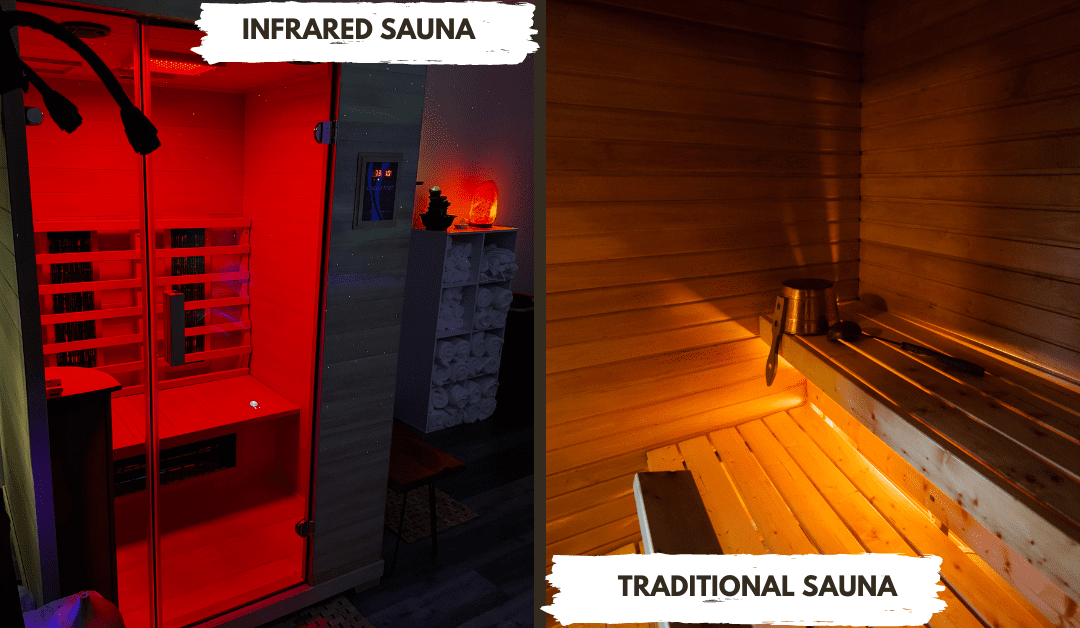Infrared Sauna vs Traditional Sauna: Which One Is Safer for Daily Use?
At Physiopros Performance Rehab, we’re all about helping you feel your best. Whether you’re recovering from an injury, boosting your fitness, or simply looking to unwind. One popular method that people turn to for relaxation and wellness is the sauna. However, when it comes to daily use, not all saunas are the same. The choice often boils down to infrared saunas vs traditional saunas, but which one is actually safer for everyday use?
In this post, we’ll break down the key differences between the two, explore the potential risks and benefits, and help you decide which sauna might be the better fit for your wellness routine. By understanding how each type of sauna works and its impact on your body, you’ll be able to make a more informed choice, so let’s dive in! Also, make sure to check out our complete recovery room by clicking here: Recovery Room Experience.
Understanding the Basics of Saunas
Traditional Sauna
A traditional sauna is what most people picture when they think of a classic sauna experience. These saunas use a heat source, typically a wood-burning or electric stove, to warm the air inside the room. Temperatures can reach anywhere from 150°F to 190°F, and the humidity is often increased by pouring water over hot stones, creating that familiar steam.
The heat in a traditional sauna causes your body to sweat and your heart rate to rise, providing several benefits. These include improved circulation, muscle relaxation, and detoxification through sweat. However, because the temperatures are so high, some people may find it difficult to stay inside for long periods, especially if they aren’t used to the intense heat.
Infrared Sauna
An infrared sauna works a bit differently. Instead of heating the air around you, it uses infrared panels to heat your body directly. The temperatures in infrared saunas are typically much lower, ranging from 120°F to 160°F, making the experience feel less intense while still promoting sweating and relaxation.
Infrared saunas are known for their ability to penetrate deeper into the skin and tissues, which is why some people believe they offer more therapeutic benefits. Additionally, since they don’t rely on heating the air, infrared saunas are often more energy-efficient and can be used in smaller spaces, making them a popular choice for home setups.
Both types of saunas offer similar wellness benefits, but the way they deliver heat and how they affect your body can vary greatly. Understanding these differences is the first step in deciding which option is better for your daily use.
Comparing the Safety of Infrared Sauna vs Traditional Saunas
Heat Exposure and Daily Use
The biggest difference between infrared and traditional saunas is the way they deliver heat. Traditional saunas operate at much higher temperatures (150°F to 190°F), creating an intense, dry heat that can be taxing on your body. For daily use, this may be uncomfortable or even unsafe for some people, as the high temperatures can lead to overheating or dehydration.
On the other hand, infrared saunas use lower temperatures (120°F to 160°F) while still promoting sweating. The infrared heat penetrates deeper into your body, warming you from the inside out without the overwhelming air temperature of a traditional sauna. This gentler heat makes infrared saunas more tolerable for longer sessions and, for most people, safer for daily use.
Hydration and Dehydration
Because traditional saunas rely on high heat to induce sweating, they can quickly lead to dehydration if you’re not careful. The intense heat causes rapid fluid loss, which can be risky if you aren’t drinking enough water before and after your session. This is especially true if you plan to use a traditional sauna on a daily basis.
Infrared saunas still make you sweat, but at a slower, more controlled rate. While it’s still important to stay hydrated, the lower temperatures reduce the risk of severe dehydration, making it safer to use every day without putting excessive strain on your body.
Heart Health and Circulation
Traditional saunas give your cardiovascular system a real workout, causing your heart rate to rise significantly as your body tries to cool down in the high temperatures. For healthy individuals, this is a great way to promote circulation, but it can be risky for those with heart conditions or high blood pressure. The intense heat can increase your heart rate and blood pressure to potentially unsafe levels if used frequently.
Infrared saunas, with their lower heat, are much gentler on the cardiovascular system. While they still promote circulation and increase heart rate, the effect is less intense, which may be safer for people with heart concerns. This makes infrared saunas a more practical option for daily use, especially if you have pre-existing health conditions.
Skin and Tissue Concerns
Both types of saunas can have positive effects on your skin, helping with circulation, detoxification, and overall glow. However, the extreme heat of traditional saunas may irritate sensitive skin or exacerbate conditions like eczema or rosacea. The dry air and intense heat can also cause dryness or irritation, especially with frequent use.
Infrared saunas operate at lower temperatures, making them gentler on your skin. However, the deeper penetration of infrared heat into tissues raises some concerns about long-term exposure and potential effects on skin health. While there’s no solid evidence of harm, it’s something to consider if you’re planning to use an infrared sauna daily.
Which Sauna is Safer for Daily Use?
When choosing between an infrared sauna vs traditional sauna for daily use, several factors come into play to ensure you’re making the safest choice. For older individuals or those with mobility issues, infrared saunas often provide a more manageable experience due to their lower temperatures. They are also generally safer for people with heart conditions, high blood pressure, or respiratory issues, as the gentler heat poses less strain on the cardiovascular system. If you have specific health concerns, it’s always wise to consult with your healthcare provider. On the other hand, if you’re accustomed to and enjoy the intense heat of a traditional sauna, and you can manage the higher temperatures safely, it can still be a good choice for occasional use.
However, for daily use, the infrared sauna’s milder temperatures and reduced risk of dehydration and cardiovascular stress make it the better option for most people. The ability to enjoy longer, more comfortable sessions with infrared saunas often outweighs the benefits of the traditional sauna’s intense heat, especially for frequent use. Ultimately, your personal preferences, health conditions, and how your body responds to different heat levels will guide your choice. By listening to your body and considering professional advice, you can find the sauna that best fits your daily wellness routine.
FAQ
Q1: Can I use a traditional sauna every day?
Using a traditional sauna every day is possible, but it can be intense due to the high temperatures. This frequent exposure may lead to dehydration or strain on your cardiovascular system. For daily use, it’s crucial to stay well-hydrated and listen to your body’s signals. If you’re new to saunas or have health concerns, you might want to limit usage to a few times a week and gradually increase frequency.
Q2: Is infrared sauna better for detoxing?
Both infrared and traditional saunas promote detoxification through sweating. However, infrared saunas often allow for longer, more comfortable sessions at lower temperatures, which some believe might lead to more gradual detoxification. While the detox benefits of infrared saunas are well-regarded, both types of saunas are effective for helping your body eliminate toxins.
Q3: What’s the ideal session time for each sauna type?
For traditional saunas, sessions typically last about 15-20 minutes due to the high heat. For infrared saunas, sessions can be longer, often ranging from 30 to 45 minutes, thanks to the lower temperatures. Always listen to your body and adjust session times based on your comfort level and how you feel.
Q4: Which sauna is better for people with heart conditions?
Infrared saunas are generally considered safer for people with heart conditions due to their lower heat levels, which place less stress on the cardiovascular system. Traditional saunas, with their higher temperatures, can significantly increase heart rate and blood pressure, so it’s best for individuals with heart concerns to opt for infrared saunas and consult their doctor before use.
Conclusion
Whether you’re aiming for deep relaxation, detoxification, or improved circulation, we believe that for the battle of Infrared Sauna vs Traditional Sauna, the Infrared Sauna is the clear winner. Luckily for you, at Physiopros Performance Rehab located in Parsippany, NJ we offer not only an Infrared Sauna but also Normatec Compression Boots and a Cold Plunge as part of our recovery room experience. Be sure to check out what our Recovery Room looks like here: Recovery Room Instagram Stories.
Call us at 973-265-8621 for all of your recovery needs and to try out our Infrared Sauna today. You can also schedule an appointment online here: Book a Consultation Today!


Do you specific recommendations on infrared saunas? I am looking for an indoor 3 person sauna for my gym area.
Thanks for your comment John. Hi-Tech Health is the sauna company we use. Highest quality and has the lowest EMFs!